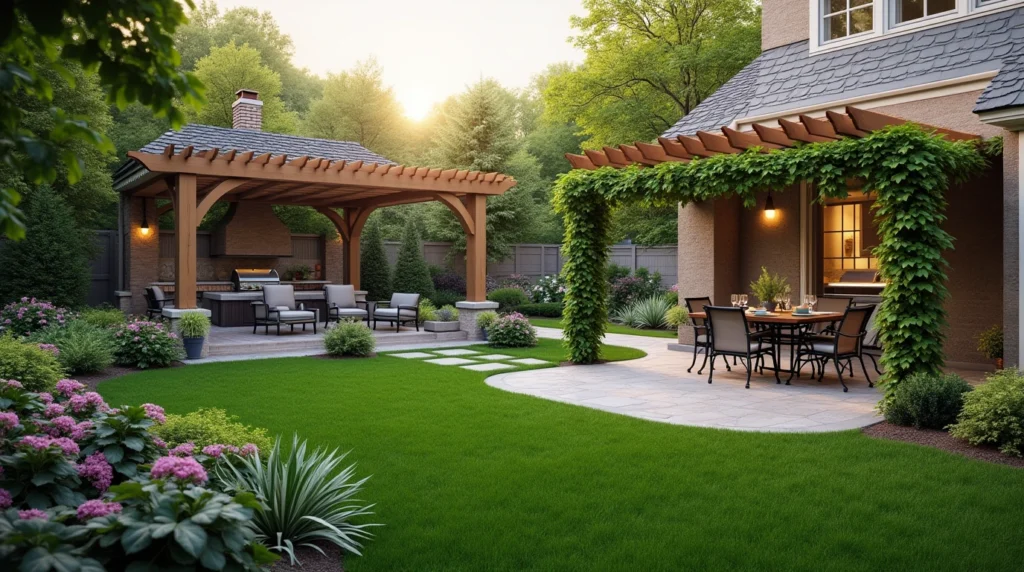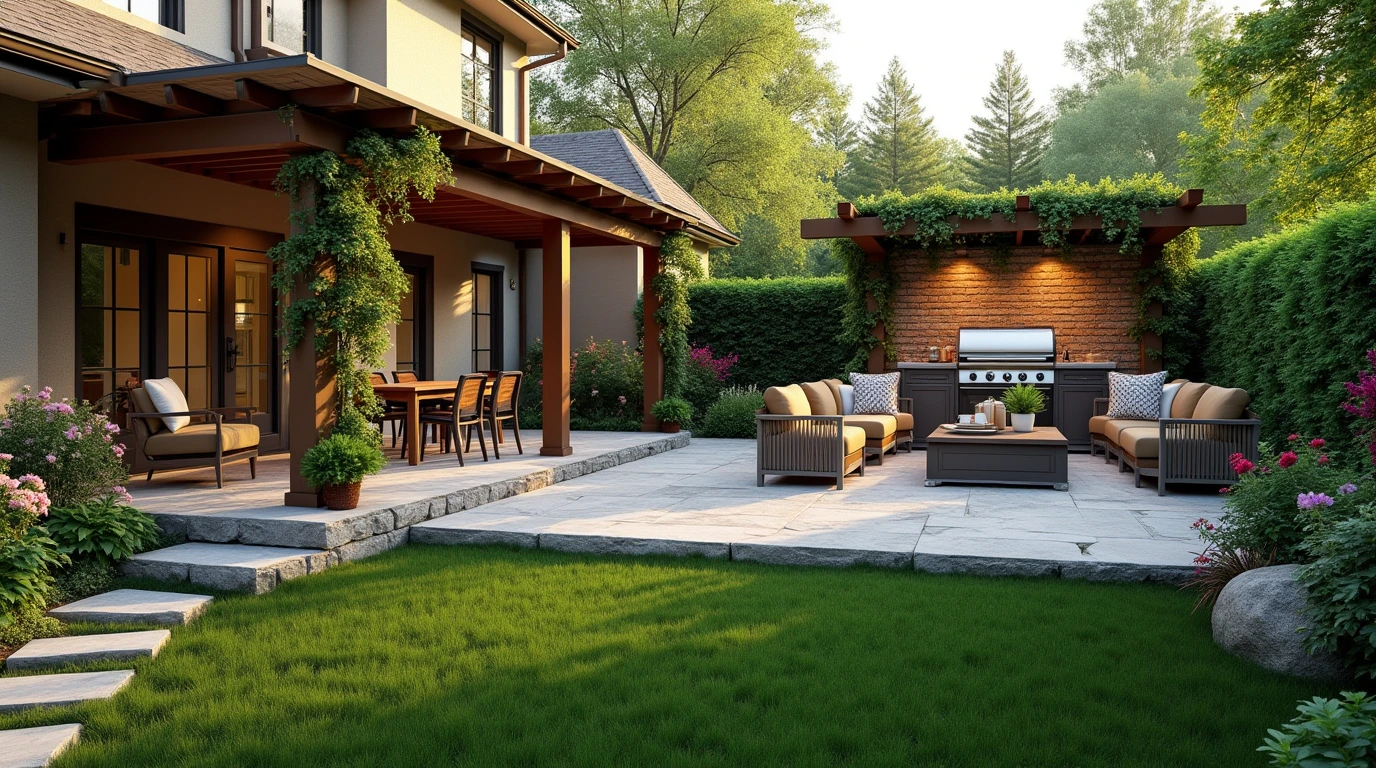When I first bought my home, the backyard was nothing more than a rough patch of grass and a whole lot of potential. I had big dreams, but no clear plan. Over time, with trial, error, and a lot of digging, I learned just how powerful a smart backyard layout can be. Whether you’re working with a tiny city space or a sprawling lawn, a thoughtful design can turn your backyard into a personal haven. Trust me, it’s more achievable than you think.
Table of Contents
Why a Thoughtful Backyard Layout Matters
A well-planned backyard layout does more than just look good. Here’s why it’s so important:
- Maximizes your usable space
- Creates flow between different activities (like dining, playing, and relaxing)
- Boosts your home’s curb appeal
- Increases property value
- Makes maintenance easier and more manageable
Taking the time to map out your space ensures that every square foot works for you, not against you.
Key Elements to Consider for Your Backyard Layout
Assess Your Space
Before you grab a shovel, spend some time studying your backyard:
- Size and shape
- Sun and shade patterns throughout the day
- Soil quality and drainage conditions
- Existing elements like trees, fences, sheds, or slopes
Define Your Needs and Priorities
Ask yourself:
- Do you need a place for entertaining?
- Are you dreaming of a vegetable garden?
- Do you want a play area for kids or pets?
- Would a quiet reading nook make you happiest?
Knowing your priorities keeps your design focused.
Create Zones for Different Activities
Think of your backyard like an open floor plan:
- Dining and cooking area (patio, outdoor kitchen, BBQ)
- Recreation zone (open lawn for games)
- Garden space (raised beds, flower borders)
- Relaxation spots (hammocks, shade trees, pergolas)
Zoning helps prevent clutter and makes the space feel intentional.
Step-by-Step Guide to Designing Your Backyard Layout

Step 1: Draw a Base Map
Creating an accurate foundation for your design is essential:
- Begin with a measured sketch of your backyard’s perimeter, noting the exact dimensions of the space.
- Document all permanent fixtures including mature trees (with canopy spread), utility connections, drainage patterns, existing structures like sheds or gazebos, and boundary fences or walls.
- Conduct a thorough sun mapping by observing your yard at different times of day (morning, noon, afternoon) across multiple seasons if possible. Mark areas that receive full sun (6+ hours), partial sun (3-6 hours), and full shade (less than 3 hours).
- Note existing soil conditions and any problematic areas with poor drainage, compaction, or erosion issues.
- Identify the views you want to highlight or screen from both inside and outside your property.
Step 2: Plan Your Zones
Thoughtful zoning creates functional, harmonious outdoor spaces:
- Use transparent overlays (tracing paper or digital layers) to experiment with different arrangements without committing to any single design.
- Create distinct activity zones based on your lifestyle needs: dining area, cooking space, play area, meditation garden, vegetable plot, or entertainment patio.
- Analyze traffic patterns between zones, ensuring natural flow and accessibility. Consider how family members and guests will move through the space.
- Position each zone strategically according to its requirements – cooking areas near house access, quiet retreats away from noise, vegetable gardens in full sun, and shade-loving plants under tree canopies.
- Evaluate sight lines from key indoor viewing points like kitchen windows, living rooms, or home offices to ensure pleasant views and visual connections between indoor and outdoor spaces.
Step 3: Choose Materials and Plants
Selecting the right elements creates cohesion and sustainability:
- Hardscaping:
- Select materials that complement your home’s architecture – consider concrete pavers for modern homes, natural stone for traditional styles, or composite decking for low-maintenance options.
- Factor in your climate when choosing materials – porous surfaces for rainy regions, heat-resistant materials for hot climates, or freeze-thaw resistant options for cold areas.
- Balance permeable and non-permeable surfaces to manage rainwater runoff and support groundwater recharge.
- Softscaping:
- Create plant combinations with year-round interest by mixing deciduous and evergreen species, varying bloom times, and incorporating plants with distinctive seasonal characteristics.
- Select native or well-adapted non-invasive species that thrive in your specific climate zone, soil type, and sun exposure with minimal intervention.
- Layer plants by height – ground covers, perennials, shrubs, and trees – to create visual depth and maximize growing space.
- Group plants with similar water, sun, and soil requirements together to facilitate efficient maintenance and resource use.
Step 4: Add Personal Touches
Distinctive elements transform a designed space into your personal sanctuary:
- Water features can be scaled to your space – from simple bubbling boulders for small yards to reflecting pools or naturalistic streams in larger landscapes. Consider both visual impact and the soothing acoustic properties water brings.
- Develop a comprehensive lighting plan with varied fixtures – path lights for safety, uplighting to highlight specimen trees or architecture, downlighting for gentle ambient illumination, and specialty fixtures like string lights or lanterns for entertaining areas.
- Incorporate meaningful artistic elements that express your personality – weatherproof art installations, custom metalwork, mosaic stepping stones, or a collection of sculptural plants.
- Create sensory experiences with fragrant plants strategically placed near seating areas, textural contrasts in plantings, and elements that attract beneficial wildlife like butterflies and songbirds.
- Consider seasonal adaptability with convertible spaces that transition smoothly from summer entertaining to cozy fall gatherings with features like fire pits, outdoor heaters, or wind screens.
Smart Tips for a Functional and Beautiful Backyard Layout
Maximize Space Smartly
- Use vertical gardening with trellises or wall planters.
- Choose multi-purpose furniture like benches with storage.
Think About Seasonal Changes
- Plant deciduous trees for shade in summer and sun in winter.
- Add a fire pit or cozy corner for cooler evenings.
Keep Maintenance in Mind
- Choose drought-resistant plants if you live in a dry area.
- Install irrigation systems to save time and water.
Popular Backyard Layout Ideas
Looking for inspiration? Try these popular styles:
- ✅ Modern minimalist: clean lines, neutral colors, structured plants
- ✅ Garden retreat: lush, colorful flowers, winding paths, hidden corners
- ✅ Family fun zone: open lawn for sports, sandbox for kids
- ✅ Entertainer’s paradise: large patio, fire pit, outdoor kitchen
- ✅ Eco-friendly backyard: native plants, rain garden, composting area
Mistakes to Avoid in Backyard Layouts
Avoid these common pitfalls:
- Ignoring the natural sun and shade patterns.
- Overcrowding plants or structures.
- Forgetting to plan for maintenance.
- Lack of clear pathways between zones.
- Not accounting for proper drainage.
Fixing these mistakes later can cost time and money, so it’s better to plan carefully from the start.
Bonus: Quick Planting Guide by Zone
- Full Sun: Lavender, roses, tomatoes
- Partial Shade: Hostas, hydrangeas, lettuce
- Full Shade: Ferns, begonias, astilbe
FAQs About Backyard Layout
How do I start designing my Backyarrd Layout if I have a small space?
Focus on your top priorities. Use vertical elements like trellises, narrow garden beds, and choose compact furniture to maximize every inch.
What is the best layout for a low-maintenance Backyard?
- Choose hardscaping like patios or gravel paths.
- Plant native, drought-tolerant species.
- Install a drip irrigation system for easy watering.
How do I make my Backyard Layout look bigger?
- Use diagonal pathways to create an illusion of space.
- Place larger plants or trees along the edges.
- Keep the center open and uncluttered.
Conclusion: Your Backyard Layout, Your Outdoor Oasis
Designing your backyard layout is about more than just placing furniture and plants — it’s about crafting a place that reflects your life and dreams. Whether it’s a quiet garden for reading, a lively space for family BBQs, or a little bit of everything, your backyard should make you happy every time you step outside. With a little thought and planning, even the plainest backyard can become a beautiful, functional outdoor oasis.
